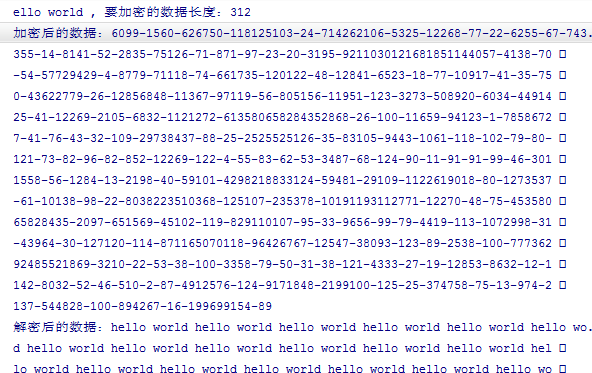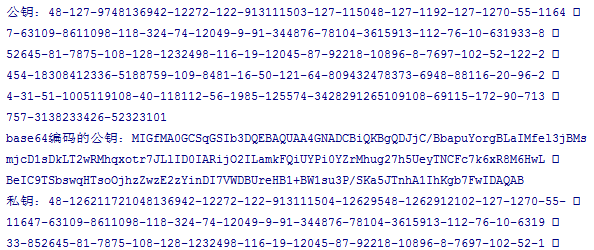жӮЁеҘҪпјҢзҷ»еҪ•еҗҺжүҚиғҪдёӢи®ўеҚ•е“ҰпјҒ
иҝҷжңҹеҶ…е®№еҪ“дёӯе°Ҹзј–е°Ҷдјҡз»ҷеӨ§е®¶еёҰжқҘжңүе…іжҖҺд№ҲеңЁAndroidдёӯеҲ©з”ЁRSAз®—жі•иҝӣиЎҢеҠ еҜҶе’Ңи§ЈеҜҶпјҢж–Үз« еҶ…е®№дё°еҜҢдё”д»Ҙдё“дёҡзҡ„и§’еәҰдёәеӨ§е®¶еҲҶжһҗе’ҢеҸҷиҝ°пјҢйҳ…иҜ»е®ҢиҝҷзҜҮж–Үз« еёҢжңӣеӨ§е®¶еҸҜд»ҘжңүжүҖ收иҺ·гҖӮ
дёҖгҖҒе…¬й’ҘеҠ еҜҶе’Ңз§Ғй’Ҙи§ЈеҜҶ
/**RSAз®—жі•*/
public static final String RSA = "RSA";
/**еҠ еҜҶж–№ејҸпјҢandroidзҡ„*/
// public static final String TRANSFORMATION = "RSA/None/NoPadding";
/**еҠ еҜҶж–№ејҸпјҢж ҮеҮҶjdkзҡ„*/
public static final String TRANSFORMATION = "RSA/None/PKCS1Padding";
/** дҪҝз”Ёе…¬й’ҘеҠ еҜҶ */
public static byte[] encryptByPublicKey(byte[] data, byte[] publicKey) throws Exception {
// еҫ—еҲ°е…¬й’ҘеҜ№иұЎ
X509EncodedKeySpec keySpec = new X509EncodedKeySpec(publicKey);
KeyFactory keyFactory = KeyFactory.getInstance("RSA");
PublicKey pubKey = keyFactory.generatePublic(keySpec);
// еҠ еҜҶж•°жҚ®
Cipher cp = Cipher.getInstance(TRANSFORMATION);
cp.init(Cipher.ENCRYPT_MODE, pubKey);
return cp.doFinal(data);
}
/** дҪҝз”Ёз§Ғй’Ҙи§ЈеҜҶ */
public static byte[] decryptByPrivateKey(byte[] encrypted, byte[] privateKey) throws Exception {
// еҫ—еҲ°з§Ғй’ҘеҜ№иұЎ
PKCS8EncodedKeySpec keySpec = new PKCS8EncodedKeySpec(privateKey);
KeyFactory kf = KeyFactory.getInstance(RSA);
PrivateKey keyPrivate = kf.generatePrivate(keySpec);
// и§ЈеҜҶж•°жҚ®
Cipher cp = Cipher.getInstance(TRANSFORMATION);
cp.init(Cipher.DECRYPT_MODE, keyPrivate);
byte[] arr = cp.doFinal(encrypted);
return arr;
}1.dataжҳҜиҰҒеҠ еҜҶзҡ„ж•°жҚ®пјҢеҰӮжһңжҳҜеӯ—з¬ҰдёІеҲҷgetBytesгҖӮpublicKeyжҳҜе…¬й’ҘпјҢprivateKeyжҳҜз§Ғй’ҘгҖӮиҮӘе®ҡд№үеҜҶй’ҘеҜ№жөӢиҜ•
String data = "hello world";
try {
int keyLength = 1024;
//з”ҹжҲҗеҜҶй’ҘеҜ№
KeyPair keyPair = RSAUtils.generateRSAKeyPair(keyLength);
//иҺ·еҸ–е…¬й’Ҙ
byte[] publicKey = RSAUtils.getPublicKey(keyPair);
//иҺ·еҸ–з§Ғй’Ҙ
byte[] privateKey = RSAUtils.getPrivateKey(keyPair);
//з”Ёе…¬й’ҘеҠ еҜҶ
byte[] encrypt = RSAUtils.encryptByPublicKey(data.getBytes(), publicKey);
Log.d("TAG", "еҠ еҜҶеҗҺзҡ„ж•°жҚ®пјҡ" + StringUtils.byteArrayToString(encrypt));
//з”Ёз§Ғй’Ҙи§ЈеҜҶ
byte[] decrypt = RSAUtils.decryptByPrivateKey(encrypt, privateKey);
Log.d("TAG", "и§ЈеҜҶеҗҺзҡ„ж•°жҚ®пјҡ" + new String(decrypt, "utf-8"));
} catch (Exception e) {
e.printStackTrace();
}
2.д»Һж–Ү件дёӯиҜ»еҸ–е…¬й’Ҙ

String data = "hello world";
//иҜ»еҸ–е…¬й’Ҙж–Ү件
String publicKeyString = IOUtils.readAssetsFile(this, "rsa_public_key.pem");
//base64и§Јз Ғ
byte[] publicKey = Base64Utils.decodeToBytes(publicKeyString);
try {
//еҠ еҜҶ
byte[] encrypt = RSAUtils.encryptByPublicKey(data.getBytes(), publicKey);
Log.d("TAG", "еҠ еҜҶеҗҺзҡ„ж•°жҚ®пјҡ" + StringUtils.byteArrayToString(encrypt));
// //иҜ»еҸ–з§Ғй’Ҙж–Ү件
// String privateKeyString = IOUtils.readAssetsFile(this, "rsa_private_key.pem");
// //base64и§Јз Ғ
// byte[] privateKey = Base64Utils.decodeToBytes(privateKeyString);
// //и§ЈеҜҶ
// byte[] decrypt = RSAUtils.decryptByPrivateKey(encrypt, privateKey);
// Log.d("TAG", "и§ЈеҜҶеҗҺзҡ„ж•°жҚ®пјҡ" + new String(decrypt, "utf-8"));
} catch (Exception e) {
e.printStackTrace();
}дәҢгҖҒе…¬й’ҘеҲҶж®өеҠ еҜҶе’Ңз§Ғй’ҘеҲҶж®өи§ЈеҜҶ
еҪ“еҠ еҜҶзҡ„ж•°жҚ®иҝҮй•ҝж—¶пјҢдјҡеҮәзҺ°javax.crypto.IllegalBlockSizeException: Data must not be longer than 117 bytesзҡ„ејӮеёёгҖӮrsa算法规е®ҡдёҖж¬ЎеҠ еҜҶзҡ„ж•°жҚ®дёҚиғҪи¶…иҝҮз”ҹжҲҗеҜҶй’ҘеҜ№ж—¶зҡ„keyLength/8-11пјҢkeyLengthдёҖиҲ¬жҳҜ1024дёӘеӯ—иҠӮпјҢеҲҷеҠ еҜҶзҡ„ж•°жҚ®дёҚиғҪи¶…иҝҮ117дёӘеӯ—иҠӮ
/**з§ҳй’Ҙй»ҳи®Өй•ҝеәҰ*/
public static final int DEFAULT_KEY_SIZE = 1024;
/**еҠ еҜҶзҡ„ж•°жҚ®жңҖеӨ§зҡ„еӯ—иҠӮж•°пјҢеҚі117дёӘеӯ—иҠӮ*/
public static final int DEFAULT_BUFFERSIZE = (DEFAULT_KEY_SIZE / 8) - 11;
/**еҪ“еҠ еҜҶзҡ„ж•°жҚ®и¶…иҝҮDEFAULT_BUFFERSIZEпјҢеҲҷдҪҝз”ЁеҲҶж®өеҠ еҜҶ*/
public static final byte[] DEFAULT_SPLIT = "#PART#".getBytes();
/** дҪҝз”Ёе…¬й’ҘеҲҶж®өеҠ еҜҶ */
public static byte[] encryptByPublicKeyForSpilt(byte[] data, byte[] publicKey) throws Exception{
int dataLen = data.length;
if (dataLen <= DEFAULT_BUFFERSIZE) {
return encryptByPublicKey(data, publicKey);
}
List<Byte> allBytes = new ArrayList<Byte>(2048);
int bufIndex = 0;
int subDataLoop = 0;
byte[] buf = new byte[DEFAULT_BUFFERSIZE];
for (int i = 0; i < dataLen; i++) {
buf[bufIndex] = data[i];
if (++bufIndex == DEFAULT_BUFFERSIZE || i == dataLen - 1) {
subDataLoop++;
if (subDataLoop != 1) {
for (byte b : DEFAULT_SPLIT) {
allBytes.add(b);
}
}
byte[] encryptBytes = encryptByPublicKey(buf, publicKey);
for (byte b : encryptBytes) {
allBytes.add(b);
}
bufIndex = 0;
if (i == dataLen - 1) {
buf = null;
} else {
buf = new byte[Math
.min(DEFAULT_BUFFERSIZE, dataLen - i - 1)];
}
}
}
byte[] bytes = new byte[allBytes.size()];
int i = 0;
for (Byte b : allBytes) {
bytes[i++] = b.byteValue();
}
return bytes;
}
/** дҪҝз”Ёз§Ғй’ҘеҲҶж®өи§ЈеҜҶ */
public static byte[] decryptByPrivateKeyForSpilt(byte[] encrypted, byte[] privateKey) throws Exception {
int splitLen = DEFAULT_SPLIT.length;
if (splitLen <= 0) {
return decryptByPrivateKey(encrypted, privateKey);
}
int dataLen = encrypted.length;
List<Byte> allBytes = new ArrayList<Byte>(1024);
int latestStartIndex = 0;
for (int i = 0; i < dataLen; i++) {
byte bt = encrypted[i];
boolean isMatchSplit = false;
if (i == dataLen - 1) {
// еҲ°dataзҡ„жңҖеҗҺдәҶ
byte[] part = new byte[dataLen - latestStartIndex];
System.arraycopy(encrypted, latestStartIndex, part, 0, part.length);
byte[] decryptPart = decryptByPrivateKey(part, privateKey);
for (byte b : decryptPart) {
allBytes.add(b);
}
latestStartIndex = i + splitLen;
i = latestStartIndex - 1;
} else if (bt == DEFAULT_SPLIT[0]) {
// иҝҷдёӘжҳҜд»Ҙsplit[0]ејҖеӨҙ
if (splitLen > 1) {
if (i + splitLen < dataLen) {
// жІЎжңүи¶…еҮәdataзҡ„иҢғеӣҙ
for (int j = 1; j < splitLen; j++) {
if (DEFAULT_SPLIT[j] != encrypted[i + j]) {
break;
}
if (j == splitLen - 1) {
// йӘҢиҜҒеҲ°splitзҡ„жңҖеҗҺдёҖдҪҚпјҢйғҪжІЎжңүbreakпјҢеҲҷиЎЁжҳҺе·Із»ҸзЎ®и®ӨжҳҜsplitж®ө
isMatchSplit = true;
}
}
}
} else {
// splitеҸӘжңүдёҖдҪҚпјҢеҲҷе·Із»ҸеҢ№й…ҚдәҶ
isMatchSplit = true;
}
}
if (isMatchSplit) {
byte[] part = new byte[i - latestStartIndex];
System.arraycopy(encrypted, latestStartIndex, part, 0, part.length);
byte[] decryptPart = decryptByPrivateKey(part, privateKey);
for (byte b : decryptPart) {
allBytes.add(b);
}
latestStartIndex = i + splitLen;
i = latestStartIndex - 1;
}
}
byte[] bytes = new byte[allBytes.size()];
int i = 0;
for (Byte b : allBytes) {
bytes[i++] = b.byteValue();
}
return bytes;
}жөӢиҜ•еҲҶж®өеҠ еҜҶе’Ңи§ЈеҜҶ
String data = "hello world hello world hello world hello world hello world hello world hello world hello world " +
"hello world hello world hello world hello world hello world hello world hello world hello world hello world " +
"hello world hello world hello world hello world hello world hello world hello world hello world hello world ";
Log.d("TAG", "иҰҒеҠ еҜҶзҡ„ж•°жҚ®пјҡ" + data + ", иҰҒеҠ еҜҶзҡ„ж•°жҚ®й•ҝеәҰпјҡ" + data.length());
try {
//еҲҶж®өеҠ еҜҶ
byte[] encrypt = RSAUtils.encryptByPublicKeyForSpilt(data.getBytes(), publicKey);
Log.d("TAG", "еҠ еҜҶеҗҺзҡ„ж•°жҚ®пјҡ" + StringUtils.byteArrayToString(encrypt));
//еҲҶж®өи§ЈеҜҶ
byte[] decrypt = RSAUtils.decryptByPrivateKeyForSpilt(encrypt, privateKey);
Log.d("TAG", "и§ЈеҜҶеҗҺзҡ„ж•°жҚ®пјҡ" + new String(decrypt, "utf-8"));
} catch (Exception e) {
e.printStackTrace();
}дёүгҖҒз”ҹжҲҗеҜҶй’ҘеҜ№

/** з”ҹжҲҗеҜҶй’ҘеҜ№пјҢеҚіе…¬й’Ҙе’Ңз§Ғй’ҘгҖӮkeyй•ҝеәҰжҳҜ512-2048пјҢдёҖиҲ¬дёә1024 */
public static KeyPair generateRSAKeyPair(int keyLength) throws NoSuchAlgorithmException {
KeyPairGenerator kpg = KeyPairGenerator.getInstance(RSA);
kpg.initialize(keyLength);
return kpg.genKeyPair();
}
/** иҺ·еҸ–е…¬й’ҘпјҢжү“еҚ°дёә48-12613448136942-12272-122-913111503-126115048-12...зӯүзӯүдёҖй•ҝдёІз”Ё-жӢјжҺҘзҡ„ж•°еӯ— */
public static byte[] getPublicKey(KeyPair keyPair) {
RSAPublicKey rsaPublicKey = (RSAPublicKey) keyPair.getPublic();
return rsaPublicKey.getEncoded();
}
/** иҺ·еҸ–з§Ғй’ҘпјҢеҗҢдёҠ */
public static byte[] getPrivateKey(KeyPair keyPair) {
RSAPrivateKey rsaPrivateKey = (RSAPrivateKey) keyPair.getPrivate();
return rsaPrivateKey.getEncoded();
}з”ҹжҲҗе…¬й’Ҙе’Ңз§Ғй’ҘеҗҺпјҢз”Ёbase64зј–з Ғ
int keyLength = 1024;
try {
//з”ҹжҲҗеҜҶй’ҘеҜ№
KeyPair keyPair = RSAUtils.generateRSAKeyPair(keyLength);
//иҺ·еҸ–е…¬й’Ҙ
byte[] publicKey = RSAUtils.getPublicKey(keyPair);
Log.d("TAG", "е…¬й’Ҙпјҡ" + StringUtils.byteArrayToString(publicKey));
//е…¬й’Ҙз”Ёbase64зј–з Ғ
String encodePublic = Base64Utils.encodeToString(publicKey);
Log.d("TAG", "base64зј–з Ғзҡ„е…¬й’Ҙпјҡ" + encodePublic);
//иҺ·еҸ–з§Ғй’Ҙ
byte[] privateKey = RSAUtils.getPrivateKey(keyPair);
Log.d("TAG", "з§Ғй’Ҙпјҡ" + StringUtils.byteArrayToString(privateKey));
//з§Ғй’Ҙз”Ёbase64зј–з Ғ
String encodePrivate = Base64Utils.encodeToString(privateKey);
Log.d("TAG", "base64зј–з Ғзҡ„з§Ғй’Ҙпјҡ" + encodePrivate);
} catch (NoSuchAlgorithmException e) {
e.printStackTrace();
}
дёҠиҝ°е°ұжҳҜе°Ҹзј–дёәеӨ§е®¶еҲҶдә«зҡ„жҖҺд№ҲеңЁAndroidдёӯеҲ©з”ЁRSAз®—жі•иҝӣиЎҢеҠ еҜҶе’Ңи§ЈеҜҶдәҶпјҢеҰӮжһңеҲҡеҘҪжңүзұ»дјјзҡ„з–‘жғ‘пјҢдёҚеҰЁеҸӮз…§дёҠиҝ°еҲҶжһҗиҝӣиЎҢзҗҶи§ЈгҖӮеҰӮжһңжғізҹҘйҒ“жӣҙеӨҡзӣёе…ізҹҘиҜҶпјҢж¬ўиҝҺе…іжіЁдәҝйҖҹдә‘иЎҢдёҡиө„и®Ҝйў‘йҒ“гҖӮ
е…ҚиҙЈеЈ°жҳҺпјҡжң¬з«ҷеҸ‘еёғзҡ„еҶ…е®№пјҲеӣҫзүҮгҖҒи§Ҷйў‘е’Ңж–Үеӯ—пјүд»ҘеҺҹеҲӣгҖҒиҪ¬иҪҪе’ҢеҲҶдә«дёәдё»пјҢж–Үз« и§ӮзӮ№дёҚд»ЈиЎЁжң¬зҪ‘з«ҷз«ӢеңәпјҢеҰӮжһңж¶үеҸҠдҫөжқғиҜ·иҒ”зі»з«ҷй•ҝйӮ®з®ұпјҡis@yisu.comиҝӣиЎҢдёҫжҠҘпјҢ并жҸҗдҫӣзӣёе…іиҜҒжҚ®пјҢдёҖз»ҸжҹҘе®һпјҢе°Ҷз«ӢеҲ»еҲ йҷӨж¶үе«ҢдҫөжқғеҶ…е®№гҖӮ
жӮЁеҘҪпјҢзҷ»еҪ•еҗҺжүҚиғҪдёӢи®ўеҚ•е“ҰпјҒ